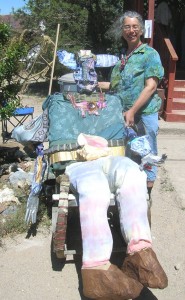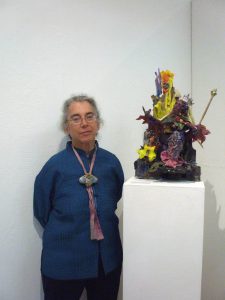Biography
Biography
Francesca Borgatta’s parents were artists and teachers. Her mother, the sculptor Isabel Borgatta, taught her to use clay and papier-mache’. She liked to use the masks and puppets she had made to act out characters. Her father, the painter Robert Borgatta taught her to draw and encouraged her use of natural materials for ‘set-ups’, small scenes. She studied modern dance with Jane Dudley who choreographed folktales for her students. The combination of narrative content with visual imagery is important to her artwork.
Francesca’s father maintained strong ties to his origins in Mexico and Italy. He took his family to the caves and cathedrals of Europe and the temples and artwork of the Yucatan. Cultural identity and communication across borders are important themes for her.
When Francesca was sixteen, she made a set of masks and props for a play based on Native American poems and rituals. At Sarah Lawrence, she studied with Joseph Chaiken, whose “Theatre Games” set a standard for group improvisation. She designed masks and costumes for a play based on Garcia Lorca’s Bernarda Alba. Her advisor, Grace Paley, introduced her to Peter Schumann of the Bread and Puppet Theater. Francesca went to work in his studio to make puppets for the anti-war demonstrations in New York.
In 1969, when she was nineteen, Francesca went to London to join Edward Berman’s Inter-Action Trust Theater. This collective worked with disadvantaged teenagers to make plays on Adventure Playgrounds. The project began with building a large ship, as a stage set for the Tempest with the materials (wood, cloth, styrofoam, cardboard, etc.) available on site. Then the group improvised with Shakespeare’s scenes and characters to develop a scenario. This experience was her introduction to the collaborative process in art-making and teaching. She also gained a new perspective on the use of available materials for on-site construction.
At the American Society of Eastern Arts, (A.S.E.A.) Francesca studied Bharata Natyam with T.Balasaraswati. This Indian dance form combines musical precision and gestural improvisation. She also studied Indonesian shadow puppetry with Pak Oemartopo. She formed the Drum, Song, and Dance Company with musicians and dancers to combine Asian art forms with personal imagery.
In 1984 Francesca studied theater at San Francisco State and earned an M.A. In Multi-Disciplinary Theater. She collaborated with Ela Youbaki, a dancer and cellist. As the Gibbous Duo, they choreographed dances combining poetry, visual projection, and live music and performed in major cities (New York, Seattle, L.A., San Francisco).
In 1984, she received a grant from the California Arts Council to develop a drama program at the San Francisco Montessori School. She worked collaboratively with her students teaching them to build sets and develop characters, to make storyboards with text and image, and to develop scenarios for performance.
As Artist-in-Residence at the Washington Elementary School in Berkeley, her project was to design art activities for the Environmental Yard, a wooded area next to the school. She used the theme California histories to build on-site installations for their plays and art installations. She taught her students to find available materials for their artwork, gave them a few techniques; then they worked collaboratively to develop their project.
At Longfellow School in Berkeley, she developed a multi-cultural art curriculum, using activities to enable teachers to incorporate art into the classroom. She initiated an outreach program for parents and community members, asking them to teach their traditional skills, including music, dance, and traditional crafts. At the end of each year, she presented an ethnic arts festival with students and community members.
Working for the East Bay Depot for Creative Re-use, she designed art workshops with recycled materials in hospitals, libraries, and festivals. She directed the construction of large processional figures for public demonstrations with the Berkeley Ecology Center. Her own work proceeded quietly during this period. In searching for materials for her classes, she found new materials to incorporate into her artwork. She began to offer her work for group shows. A higher degree of finish was required for a gallery; she fixed her work onto bases or provided wall attachment. She experimented with a tougher kind of papier-mache’ using muslin and wire mesh and embedding fabric and natural materials into the form.
In 2008, as Artist-in-Residence at St. Vincent de Paul in Oakland, she was given a studio space adjacent to the warehouse, with the stipulation that she present an exhibit. She shared her puppets with the staff and taught them to make characters using materials pulled from the conveyor belts. They were excited to find that their skills in sewing and construction were valid techniques for art-making. Francesca learned sewing techniques to improve her costume and mask construction. The exhibit, “Puppets from the Waste Stream” was accompanied by a text that identified the characters. The audience was invited to manipulate the puppets.
In 2010 at the Skyline College Gallery, Francesca had a month-long residency to install an exhibit of large puppets and dioramas and hold workshops in puppet-making. She taught the members of the dance department to improvise with a set of bird puppets, to establish flight patterns, and to use a bird’s eye view to navigate the gallery space.
At Bridge Art Space, she presented a solo show “Travellers on a Pathway”. The audience was invited to try on masks to explore a set of installations. Working with Richard Quinn, the cinematographer, she made a film using images from the exhibit and a spoken narrative. She began to experiment with video as a way to animate her puppets.
Francesca tried new forms of display and audience involvement in a series of themed exhibits at the Sidequest Gallery, The Reclaimed Room, The Orinda Library, and the McCune Library. In 2015, she was chosen as a Spotlight Artist for the Richmond Art Center.
In 2019 Francesca made a film with puppets and sets based on the Spectre’s Bride, a cantata by Antonin Dvorak. The techniques of video editing provide a range of options for layering and transforming the image. Video integrates the elements of visual imagery and narrative in a way that seems effective for her. At this time she is working on a set of puppets, and developing a scenario for a new video. She is looking for collaborative projects with other artists, and for places to exhibit her art.


